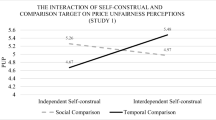Abstract
Existing research has shown that the “pennies-a-day” strategy of reframing a large aggregate expense as a small daily expense helps to reduce the perceived cost of a transaction (Nagle and Holden, 1995; Price, 1995; Gourville, 1998, 1999). This paper builds on this research and explores the robustness of the phenomenon across two dimensions – (1) the level of temporal aggregation and (2) the dollar magnitude of the transaction. First, we show that the effectiveness of a pennies-a-day strategy is not limited to per-day framing. Rather, we find a more general phenomenon in which a “less aggregate” expense is preferred to a “more aggregate” expense, such that if a per-day framing is preferred to a per-year framing, than a per-month framing also will be preferred to a per-year framing. Second, we show that this effectiveness reverses with the magnitude of the underlying expense, such that while a framing of “$1 per day” is preferred to one of “$365 per year,” a framing of “$4200 per year” is preferred to one of “$11.50 per day.”
Similar content being viewed by others
References
Chandran, Sucharita and Geeta Menon. (2002). “When a Day Means More than a Year: Effects of Temporal Framing on Judgments of Health Risks,” unpublished working paper, Department of Marketing, New York University.
Gourville, John T. (1998). “Pennies-a-Day: The Effect of Temporal Reframing on Transaction Evaluation,” Journal of Consumer Research, 24(March), 395–408.
Gourville, John T. (1999). “The Effect of Implicit versus Explicit Comparisons on Temporal Pricing Claims,” Marketing Letters, 10(2), 113–124.
Kahneman, Daniel and Amos Tversky. (1979). “Prospect Theory: An Analysis of Decision Under Risk,” Econometrica, 47(2), 363–391.
Nagle, Thomas T. and Reed K. Holden. (1995). The Strategy and Tactics of Pricing, 2nd Edition. Englewood Cliffs, NJ: Prentice-Hall Inc.
Price, Paul C. (1995). “Installment Framing: TheMental Aggregation and Disaggregation of Monetary Cost over Time,” poster presented at the Annual Meeting of the Society for Judgment and Decision Making, St. Louis, MO, November 13, 1994.
Thaler, Richard H. (1980). “Toward a Positive Theory of Consumer Choice,” Journal of Economic Behavior and Organization, 1(1), 39–60.
Thaler, Richard H. (1985). “Mental Accounting and Consumer Choice,” Marketing Science, 4(3), 199–214.
Tversky, Amos, Shmuel Sattath, and Paul Slovic. (1988). “Contingent Weighting in Judgment and Choice,” Psychological Review, 95(3), 371–384.
Author information
Authors and Affiliations
Rights and permissions
About this article
Cite this article
Gourville, J.T. The Effects of Monetary Magnitude and Level of Aggregation on the Temporal Framing of Price. Marketing Letters 14, 125–135 (2003). https://doi.org/10.1023/A:1025467002310
Issue Date:
DOI: https://doi.org/10.1023/A:1025467002310




